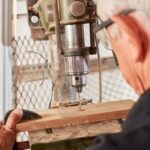What do I need to sharpen woodworking hand tools? Keeping your woodworking hand tools sharp is crucial for achieving clean cuts and precise work. In this post, we will cover the essential tools needed to sharpen woodworking hand tools, as well as the techniques and maintenance required to keep them in optimal condition.
Woodworking hand tools come in various forms, including chisels, planes, saws, and carving tools. Each of these tools plays a vital role in shaping and crafting wood, and maintaining their sharpness is key to achieving high-quality results. Understanding the anatomy of these tools and how their different parts contribute to their sharpness is essential for anyone looking to improve their woodworking skills.
In this article, we will provide a detailed description of the essential tools needed to sharpen woodworking hand tools and discuss their purpose and function. Additionally, we will offer a step-by-step guide on how to sharpen different types of woodworking hand tools effectively, along with tips and tricks for maintaining a sharp edge.
Whether you’re new to woodworking or looking to improve your sharpening skills, this post will provide valuable insights into keeping your hand tools in top condition.
Common Woodworking Hand Tools
Woodworking hand tools come in a variety of types, each serving a specific purpose in the woodworking process. Some common woodworking hand tools include chisels, planes, saws, and carving knives. Chisels are essential for cutting and shaping wood, while planes are used for smoothing and shaping wooden surfaces. Saws are necessary for cutting through wood, and carving knives are used for intricate and detailed woodwork.
It’s important to keep these hand tools sharp to ensure that they work effectively. Dull tools can not only lead to poor results in woodworking projects but also pose a safety hazard. A sharp woodworking tool will require less force to be used effectively and will produce cleaner cuts, making the entire woodworking process more efficient.
Understanding how to use each type of tool is essential for maintaining their sharpness and effectiveness. Proper technique and usage of these tools also contribute to how often they need to be sharpened. Knowing the anatomy of each tool helps users identify which parts need sharpening and how to properly care for them.
| Tool | Description |
|---|---|
| Chisels | Used for cutting and shaping wood. |
| Planes | For smoothing and shaping wooden surfaces. |
| Saws | Necessary for cutting through wood. |
| Carving Knives | Used for intricate and detailed woodwork. |
Understanding the Tools
Woodworking hand tools come in a variety of shapes and sizes, each with its own unique purpose in the crafting process. From chisels and hand planes to saws and carving knives, understanding the anatomy of these tools is crucial to maintaining their sharpness and effectiveness. At the core of each woodworking hand tool are several key components that contribute to its overall functionality.
One important part of woodworking hand tools is the cutting edge, which is responsible for making precise cuts on wood. The blade, or cutting edge, is often made of high-quality steel and must be properly sharpened to ensure clean and accurate cuts.
Another crucial component is the handle, which provides the user with a comfortable grip and control over the tool. The handle is typically made of wood, plastic, or composite materials and should be well-maintained to prevent slipping or discomfort during use.
In addition to the cutting edge and handle, many woodworking hand tools have additional features such as knobs, adjustment mechanisms, and blade guards. These components also play a role in maintaining the sharpness and overall condition of the tool. By understanding how each part contributes to the functionality of woodworking hand tools, users can better appreciate the importance of keeping them sharp and well-maintained.
| Anatomy Component | Function |
|---|---|
| Cutting Edge/Blade | Makes precise cuts on wood |
| Handle | Provides grip and control over the tool |
| Additional Features (knobs, adjustments) | Contributes to functionality and maintenance |
Essential Sharpening Tools
When it comes to sharpening woodworking hand tools, having the right equipment is crucial to achieving a sharp and effective edge. The following essential sharpening tools are necessary for maintaining the cutting abilities of your woodworking hand tools:
- Whetstones: These are perhaps the most traditional method for sharpening woodworking hand tools. They come in various grits, and a set with different grit levels will allow you to both sharpen and polish your tools effectively.
- Honing Guide: This tool helps you achieve consistent bevel angles when sharpening chisels, plane blades, and other woodworking hand tools. It ensures that the edge is uniform and sharp across the entire blade.
- Leather Strop: After using a whetstone, a leather strop is used for a final polish. It removes any remaining burrs and further refines the edge of your woodworking hand tools.
- Sharpening Jig: This tool holds the blade of chisels or plane irons at a specific angle while being sharpened. It’s especially useful for beginners who may struggle with maintaining consistent angles by hand.
These essential sharpening tools are fundamental for keeping your woodworking hand tools in top working condition. With these items in your arsenal, you’ll be able to maintain sharp edges on your chisels, planes, carving knives, and other essential tools employed in woodworking projects.
Proper maintenance includes regularly checking the sharpness of your woodworking hand tools and addressing any dullness promptly. By incorporating these essential sharpening tools into your workshop setup, you can ensure that your woodworking projects are executed with precision and efficiency.
Sharpening Techniques
Once you have acquired the necessary tools for sharpening woodworking hand tools, it’s time to learn the proper techniques for achieving a sharp and effective edge. In this section, we will provide a step-by-step guide on how to sharpen different woodworking hand tools, as well as some tips and tricks for maintaining that sharp edge.
The first step in sharpening woodworking hand tools is to assess the condition of the tool. Determine if the edge is dull or damaged, and whether it requires a simple touch-up or a complete re-sharpening. Different tools may require different methods of sharpening, so it’s important to familiarize yourself with the specific technique for each tool.
For chisels and plane blades, one common method of sharpening is using sharpening stones. These stones come in various grits, from coarse to fine, and are used to grind and hone the edge of the tool. It’s essential to maintain a consistent angle while sharpening to ensure an even and sharp edge. Honing guides can also be used to assist in keeping a steady angle during sharpening.
Another important aspect of sharpening woodworking hand tools is removing any burrs or rough edges that may occur during the sharpening process. This can be done using a leather strop or honing compound to polish and refine the edge of the tool. By following these techniques, woodworkers can ensure that their hand tools are always in optimal condition for precision work.
In addition to these basic techniques, it’s also crucial to regularly check and maintain the sharpness of woodworking hand tools. Regular touch-ups and honing can prolong the life of your tools and improve their performance. By incorporating these techniques into your woodworking routine, you can achieve consistently sharp and effective hand tools for all your projects.
Maintenance and Care
Importance of Regular Maintenance
Regular maintenance of woodworking hand tools is crucial to ensure that they remain sharp and effective for a long time. By consistently maintaining the tools, woodworkers can avoid the frustration of using dull or poorly performing tools, which can lead to subpar results in their projects. Proper maintenance also prolongs the lifespan of the tools, saving money in the long run by avoiding premature replacements.
Proper Storage and Protection
In addition to regular maintenance, it is important to store and protect sharpened woodworking hand tools properly. This includes keeping them in a dry and clean environment to prevent rusting and corrosion. It’s also essential to properly organize the tools in a way that prevents them from knocking against each other, which can cause damage to the sharp edges.
Sharpened Tools Care Tips
Once woodworking hand tools are sharpened, it’s important to handle them with care to maintain their sharpness. Avoid using excessive force when working with the tools, as this can cause unnecessary wear on the edges. Furthermore, always clean the tools after use and apply a thin coat of oil or wax to prevent moisture buildup that could lead to rust. Following these care tips will help woodworkers keep their sharpened hand tools in top condition for future use.
By following these maintenance and care guidelines, woodworkers can ensure that their sharpened woodworking hand tools remain in peak condition for effective use in their projects.
Troubleshooting and Common Problems
When it comes to sharpening woodworking hand tools, there can be a few common issues that woodworkers encounter. One of the most frequent problems is uneven sharpening, which can result in a blade that is not uniform and does not perform at its best. This can happen if the sharpening technique is not consistent or if the tool being used to sharpen the blade is not properly aligned.
Another common problem is over – or under-sharpening. Over-sharpening a woodworking hand tool can result in the blade being too thin or even changing its original shape, while under-sharpening will not achieve a sharp enough edge for optimal performance. It is important to have a keen eye and know when to stop sharpening to avoid these issues.
One last issue that woodworkers can encounter when sharpening their hand tools is damage to the blade itself. This can occur if the wrong type of sharpening stone is used, or if excessive force is applied during the sharpening process. It is essential to use the appropriate tools and techniques to prevent any unnecessary damage to the tools.
In order to avoid these common problems when sharpening woodworking hand tools, it is crucial to follow proper techniques and use the right equipment. Additionally, regularly maintaining and caring for your tools will help prevent these issues from arising in the first place. By being mindful of these potential problems, woodworkers can ensure that their hand tools are always kept sharp and ready for use.
Final Thoughts and Recommendations
In conclusion, it is crucial to keep woodworking hand tools sharp in order to achieve the best results and ensure safety while working with wood. The process of sharpening these tools may seem daunting at first, but with the right knowledge and tools, it can be a rewarding and essential skill for any woodworker.
Understanding the anatomy of woodworking hand tools is vital as it allows you to grasp the importance of each part in contributing to sharpness and effectiveness. Additionally, having the essential sharpening tools such as sharpening stones, honing guides, and strops is key to maintaining the sharpness of your woodworking hand tools.
Furthermore, proper maintenance and care are equally important in ensuring that your sharpened tools continue to perform at their best. By following the correct techniques and troubleshooting common problems that may arise during sharpening, you can improve your woodworking experience and produce high-quality results.
For further reading and resources on how to sharpen woodworking hand tools, there are various books, websites, and videos available that can provide additional guidance. Remember that by investing time in learning how to sharpen woodworking hand tools properly, you will enhance your crafting skills and enjoy a more efficient woodworking process.
Frequently Asked Questions
What Do You Use to Sharpen Hand Tools?
Hand tools are typically sharpened using sharpening stones, also known as whetstones. These stones come in various grits, from coarse to fine, and are used to grind and hone the edge of the tool to a sharp point. Some people also use diamond plates or ceramic rods for sharpening hand tools.
How Do You Sharpen Carpenter Tools?
Carpenter tools can be sharpened using similar methods as hand tools, such as sharpening stones or diamond plates. Additionally, some carpentry tools like chisels or plane irons may require specialized jigs to ensure the correct angle of the bevel when sharpening.
Power tools like bench grinders or belt sanders can also be used for faster material removal during the sharpening process.
What Tool Is Best Used for Sharpening Wood?
The best tool for sharpening wood is a dedicated woodworker’s tool called a “burnisher.” Burnishers are made of steel or carbide and have a hardened edge that is used to create a sharp hook on the edge of cabinet scrapers.
This finely honed hook is what allows woodworkers to get smooth surfaces on their workpieces, making burnishers an essential tool for anyone working with wood.

Hi everyone! I’m a woodworker and blogger, and this is my woodworking blog. In my blog, I share tips and tricks for woodworkers of all skill levels, as well as project ideas that you can try yourself.





